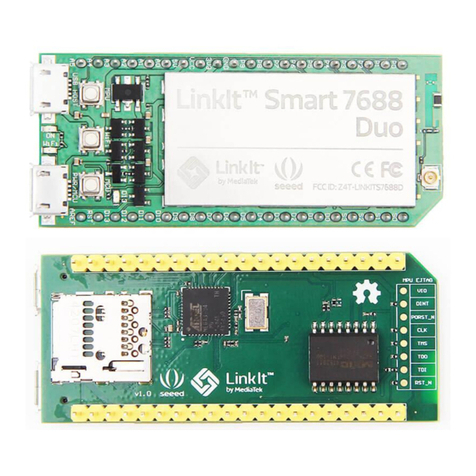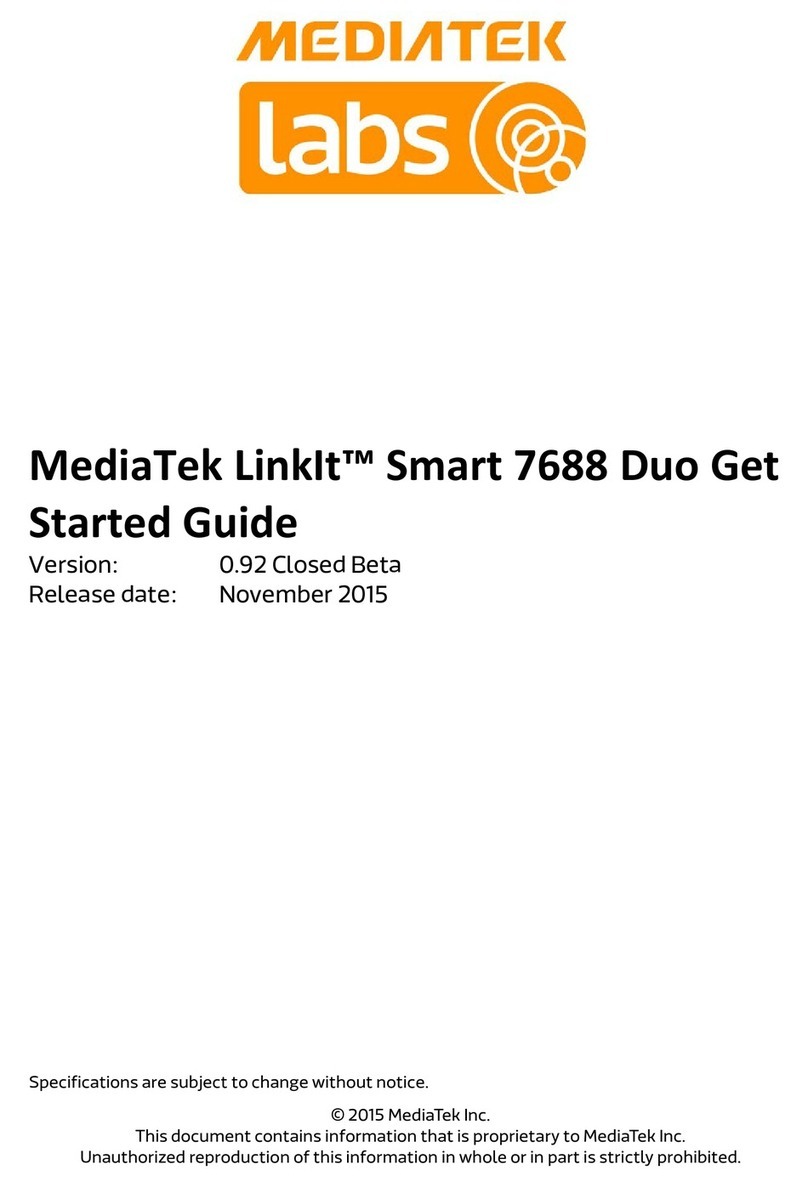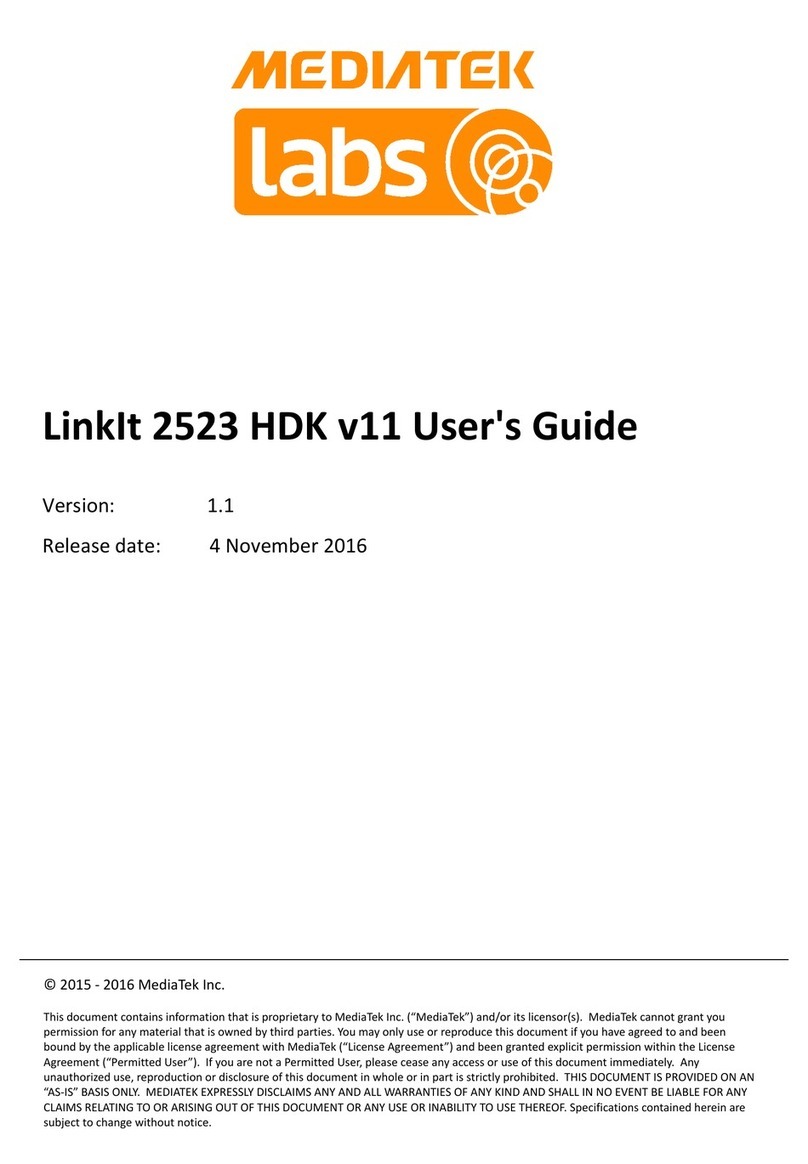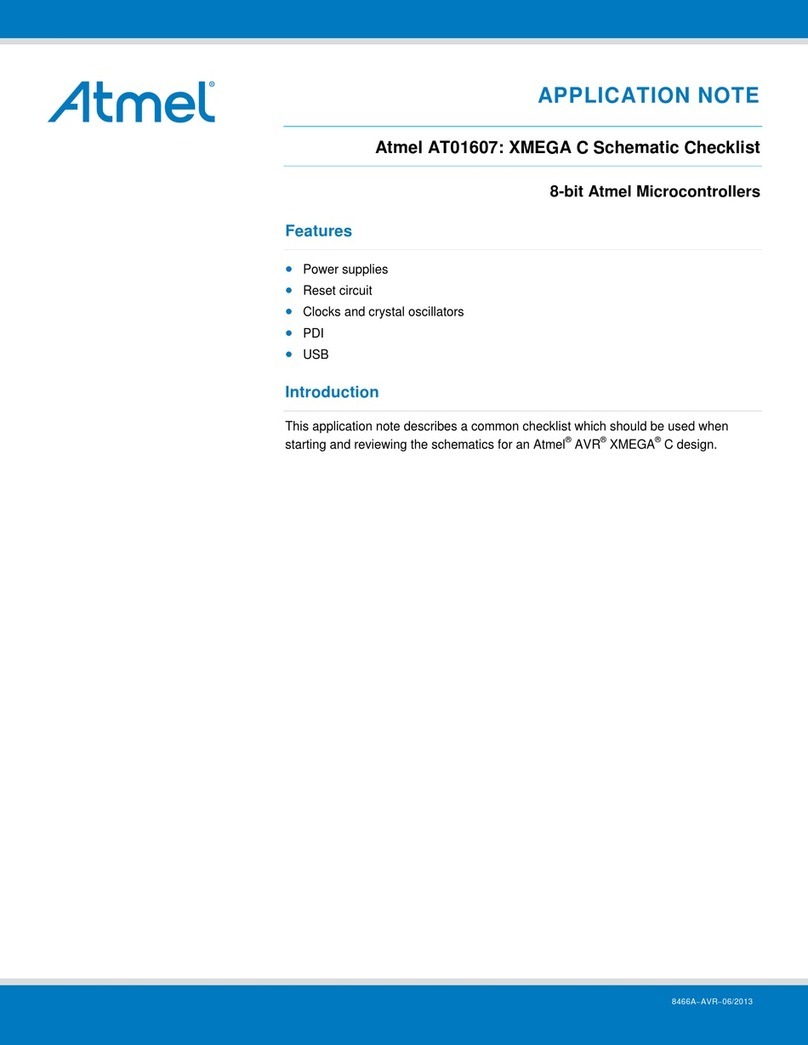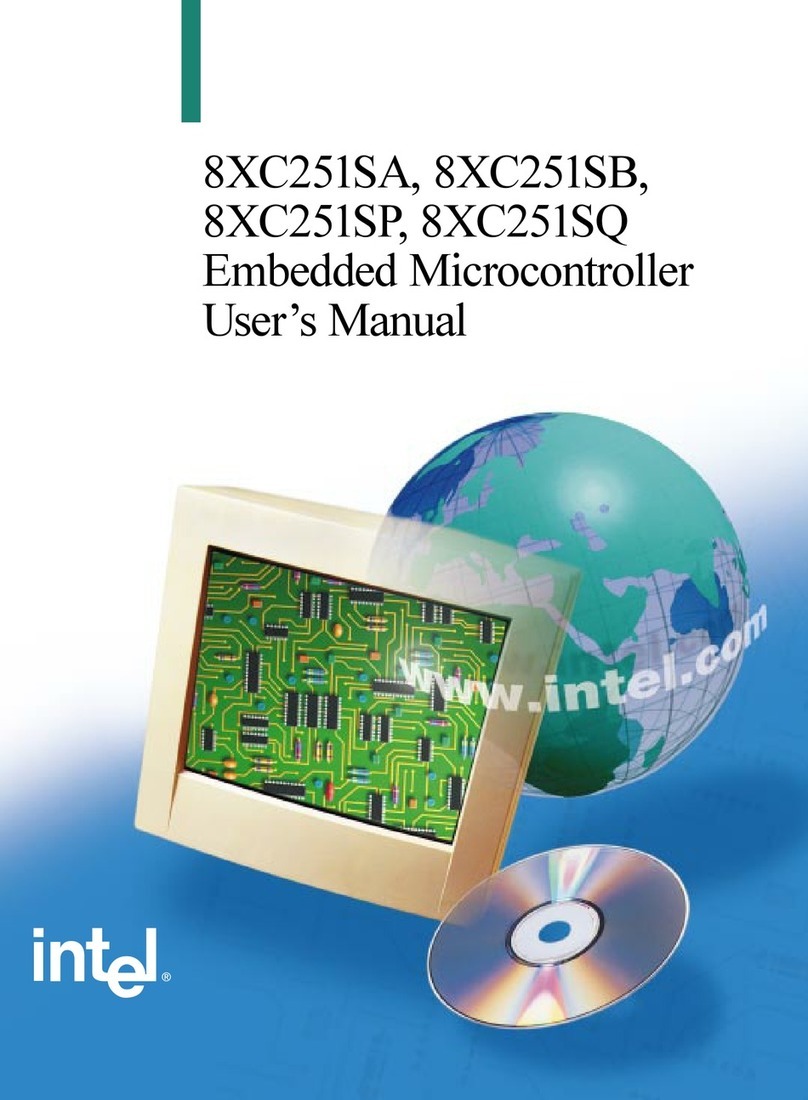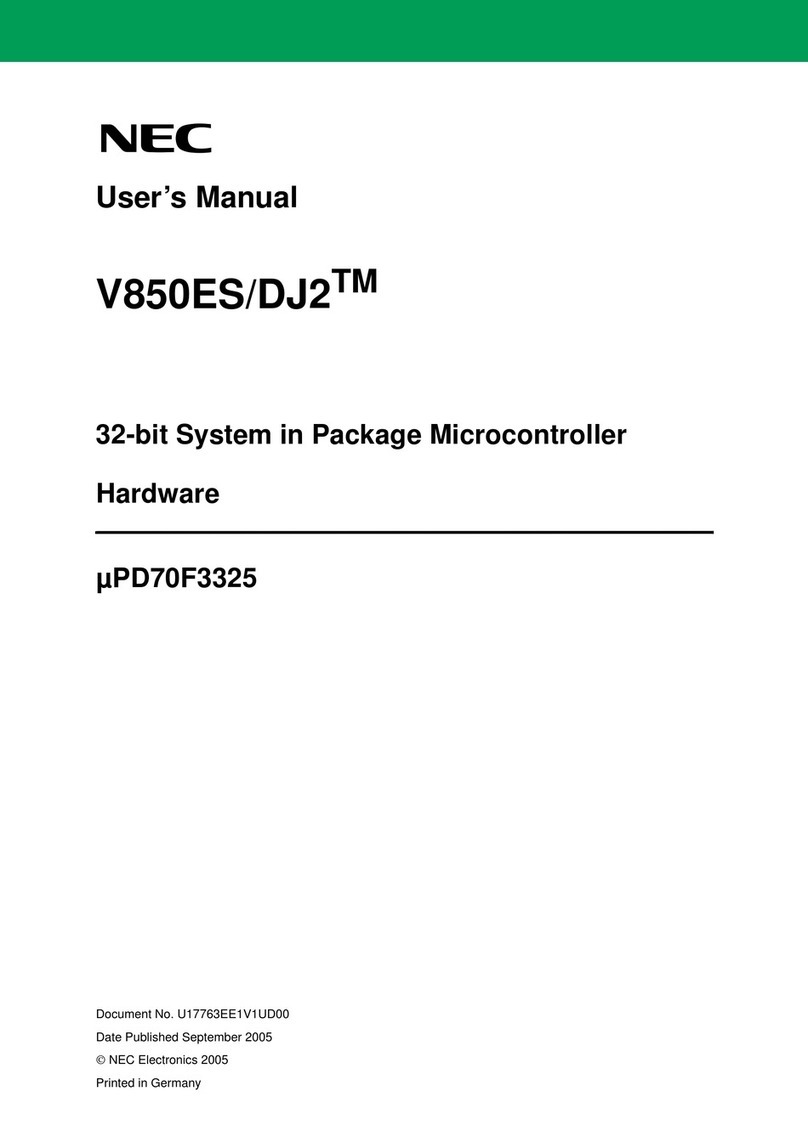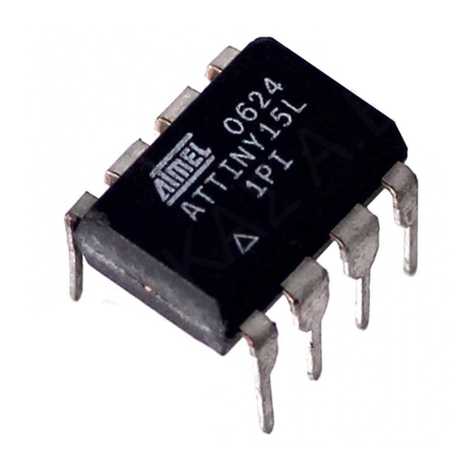MEDIATEK LinkIt Smart 7688 User manual

MediaTek LinkIt™ Smart 7688
User Manual
Version: 0.9 Beta
Release date: October 2015
Specifications are subject to change without notice.
© 2015, 2016 MediaTek Inc.
This document contains information that is proprietary to MediaTek Inc.
Unauthorized reproduction of this information in whole or in part is strictly prohibited.

MediaTek LinkIt™ Smart 7688 User Manual
Document Revision History
Revision
Date
Description
0.9
October 2015
Close Beta
© 2015, 2016 MediaTek Inc. Page 1 of 38
This document contains information that is proprietary to MediaTek Inc.
Unauthorized reproduction or disclosure of this information in whole or in part is strictly prohibited.

MediaTek LinkIt™ Smart 7688 User Manual
1. Introduction
LinkIt Smart 7688 development platform is an IoT development platform by
MediaTek Labs. It enables you to design and create Wi-Fi connected devices
for the home, the office and Cloud applications.
1.1. What is MediaTek LinkIt Smart 7688 Development
Platform
The LinkIt Smart 7688 is an open development platform based on Linux
distribution OpenWrt. It offers two development boards which come in two
hardware configurations: LinkIt Smart 7688 (MPU only) and LinkIt Smart 7688
Duo (MPU and MCU). The LinkIt Smart 7688 is powered by MediaTek’s MT7688
SOC and supports Windows, Mac OS X and Linux.
LinkIt Smart 7688 Duo has the same MPU in addition to a MCU which is
powered by ATmega32U4. It supports Arduino and high level programming
language such as Python, Node.js and C so that you can create your own
scripts for rich peripheral interactions.
The LinkIt Smart 7688 development platform supports built-in Wi-Fi,
Ethernet, USB host and Micro-SD card slot as well as serial port for Linux
console.
1.2. MediaTek MT7688AN Chip Specification Summary
Specifications of the MT7688AN SOC are shown in below.
MT7688AN SOC Specifications
CPU
MIPS24KEc (580 MHz)
Total DMIPs
580 x 1.6 DMIPs
I-Cache, D-Cache
64 KB, 32 KB
L2 Cache
N/A
Memory
•DDR1/DDR2
•16 bits
•Max. 2 Gb, 193 MHz
SPI Flash
•3B addr mode (max
128Mbit)
•4B addr mode (max
512Mbit)
SD
SD-XC (class 10)
RF
1T1R 802.11n 2.4GHz
Package
DR-QFN156-12 mm x 12 mm
Interface Count
PCIe 1
USB 2.0 1
© 2015, 2016 MediaTek Inc. Page 2 of 38
This document contains information that is proprietary to MediaTek Inc.
Unauthorized reproduction or disclosure of this information in whole or in part is strictly prohibited.

MediaTek LinkIt™ Smart 7688 User Manual
Interface Count
Fast Ethernet Switch 5
I2S 1
PCM 1
PWM 4
SPI 1
I2C 1
UART(Lite) 3
JTAG 1
Table 1 MT7688AN SOC Specification
1.3. LinkIt Smart 7688
LinkIt Smart 7688 is one of the most highly integrated and compact hardware
development boards available for IoT prototyping.
1.3.1. Key Features
LinkIt Smart 7688’s key features include the following:
•Wi-Fi 802.11 b/g/n (2.4G)
•Pin-out for GPIO, I2C, I2S, SPI, UART, PWM and Ethernet Port
•580 MHz MIPS CPU
•32MB flash and 128MB DDR2 RAM
•USB host
•Micro SD slot
LinkIt Smart 7688 is shown in Figure 1.
© 2015, 2016 MediaTek Inc. Page 3 of 38
This document contains information that is proprietary to MediaTek Inc.
Unauthorized reproduction or disclosure of this information in whole or in part is strictly prohibited.

MediaTek LinkIt™ Smart 7688 User Manual
Figure 1 LinkIt Smart 7688 development board (MPU only)
1.3.2. Buttons
The buttons description on LinkIt Smart 7688 and how to use them are
described in Table 2.
Scenario Button Action
Resets the MPU MPU Reset Button One Press
Resets Wi-Fi to
AP mode
Wi-Fi Reset
Button
(After system is
boot up)
Press for at
least 5 seconds
and release
Factory resets
and enters AP
mode
WARNING:
Restore to
default setting
and all user
data will be
Wi-Fi Reset
Button
(After system is
boot up)
Press for at
least 20 seconds
and release
© 2015, 2016 MediaTek Inc. Page 4 of 38
This document contains information that is proprietary to MediaTek Inc.
Unauthorized reproduction or disclosure of this information in whole or in part is strictly prohibited.

MediaTek LinkIt™ Smart 7688 User Manual
Scenario Button Action
removed from
the device
Upgrades
firmware from a
USB drive
Wi-Fi Reset
Button (At power
up)
Press for at
least 5 seconds
and release
Upgrades boot
loader from a
USB drive
WARNING:
Restore to
default setting
and all user
data will be
removed from
the device
Wi-Fi Reset
Button (At power
up)
Press for at
least 20 seconds
and release
Table 2LinkIt Smart 7688 Development board buttons
1.3.3. LEDs
•Power
Power LED turns solid on in green color when power is supplied.
•Wi-Fi
Wi-Fi LED are in orange color and their blink pattern is described in Table
3.For more information on Access Point and Station mode, please see 2.3,
“Network Environment”.
Table 3 Wi-Fi LED blink pattern in LinkIt Smart 7688 HDK
Mode
Status
LED blink pattern
AP Mode
With client
device
3 blinks in 1 second
and pause for 0.5
seconds (cycle
repeats)
Without client
device Off
Station
Mode
Disconnected
Off
Connecting
2 blinks in 1 second
Data
transmission
Blinking based on
the transmitted data
package
© 2015, 2016 MediaTek Inc. Page 5 of 38
This document contains information that is proprietary to MediaTek Inc.
Unauthorized reproduction or disclosure of this information in whole or in part is strictly prohibited.

MediaTek LinkIt™ Smart 7688 User Manual
1.3.4. Antenna
There are two types of antenna support available on LinkIt Smart 7688
development board:
1) Built in Wi-Fi chip antenna and it is the default antenna.
2) I-PEX connector for external antenna.
To enable the connector, you’ll need to remove the resistor R233 located on
the top left corner of the I-PEX connector, as circled in Figure 2.
Figure 2 Removing the resistor to enable I-PEX connector
1.3.5. USB Host
LinkIt Smart 7688 provides USB host capability which enables it to connect
to different USB devices such as webcams, USB drives, keyboards, joysticks
and more. The connector used is USB Micro-AB type.
1.3.6. USB Power
The USB cable provides 5V steady power source to LinkIt Smart 7688
development boards. When you add peripheral devices such as SD card, USB
drive or other USB devices to the development board, additional power may
be consumed. Please use a proper USB cable to reduce power loss. If your
peripheral device consumes power heavily, it’s better to use an external
power source for it.
The approximate power consumption of various devices used on LinkIt Smart
7688 is described in below.
Scenario
Approximate Power
Consumption
To establish Wi-
Fi connection
Peak
475.3 mA
Average
255.6 mA
Device boot up
Peak
605.4 mA
© 2015, 2016 MediaTek Inc. Page 6 of 38
This document contains information that is proprietary to MediaTek Inc.
Unauthorized reproduction or disclosure of this information in whole or in part is strictly prohibited.

MediaTek LinkIt™ Smart 7688 User Manual
Scenario
Approximate Power
Consumption
Average
195.1 mA
Downloading file
to a SD Card via
Wi-Fi
Peak
540.4 mA
Average
275.8 mA
Downloading a
file to a USB
Drive via Wi-Fi
Peak
569.5 mA
Average
304.9 mA
Downloading a
file to flash
via Wi-Fi
Peak
522.4 mA
Average
271.3 mA
Table 4 Peripherals Power Consumption
1.3.7. Accessories
LinkIt Smart 7688’s standard package comes with the development board only.
You will need additional accessories for different purposes as described
below.
1) USB Power Cable (Required): You’ll need a USB type A to
Micro-B plug cable to power the LinkIt Smart 7688
development board from a PC or other USB powered source.
2) Micro USB OTG (On-The-Go) or Host Cable (Optional):Use this
OTG cable to access Type A USB devices such as USB drive or
USB camera and more as shown in Figure 3.
Figure 3 USB OTG cable
3) USB-UART Cable (Optional): Use this cable to communicate to
Linux console.
4) Micro SD Card (Optional): Use Micro SD card for extra
storage space for applications and data.
5) USB Drive (Optional): For extra storage. You can also use it
to store bootloader and firmware to upgrade LinkIt Smart
7688.
© 2015, 2016 MediaTek Inc. Page 7 of 38
This document contains information that is proprietary to MediaTek Inc.
Unauthorized reproduction or disclosure of this information in whole or in part is strictly prohibited.

MediaTek LinkIt™ Smart 7688 User Manual
1.3.8. Breakout Board (TBD)
1.3.9. JTAG
You can use JTAG interface to debug MT7688AN. To access JTAG interface, you
will need to unsolder resistor R95 and solder it to resistor R3 on the
7688 development board. After you’ve moved the resistor and reboot the
device you’ll activate JTAG function. The steps are:
1) Find a group of resistors on the bottom side of LinkIt Smart
7688 (top-right view) as circled in below.
Figure 4 JTAG resistors on LinkIt Smart 7688 Bottom view
2) Next, you will move a resistor by unsoldering and soldering
it to a lower position as shown in below, after you’ve
finished moving the resistor, restart the device and you
should be able to activate JTAG function.
Figure 5 Moving a resistor to access JTAG mode
© 2015, 2016 MediaTek Inc. Page 8 of 38
This document contains information that is proprietary to MediaTek Inc.
Unauthorized reproduction or disclosure of this information in whole or in part is strictly prohibited.

MediaTek LinkIt™ Smart 7688 User Manual
1.3.10.Specifications
The key specifications of LinkIt Smart 7688 development boards are shown
inTable 5.
Category Feature
LinkIt Smart 7688
Spec.
MPU
Chipset
MT7688AN
Core
MIPS24KEc
Clock speed
580MHz
Working voltage
3.3V
PCB Size
Dimensions
55.7 x 26 mm
Memory
Flash
32MB
RAM
128MB DDR2
Power Source
USB Power
5V (USB Micro-B)
VCC
3.3V (Pin
Breakout)
GPIO
Pin Count
22 (MT7688AN)
Voltage
3.3v
PWM
Pin Count
4 (MT7688AN)
Voltage
3.3v
Max. Resolution
7 bits
(customizable)
Maximum
Frequency@Resoluti
on
100kHz@1-bit
50kHz@2-bit
25kHz@3-bit
12.5kHz@4-bit
6.25kHz@5-bit
3.125kHz@6-bit
1.5625kHz@7-bit
(Standard mode)
40MHz@1-bit
20MHz@2-bit
10MHz@3-bit
5MHz@4-bit
2.5MHz@5-bit
1.25Mhz@6-bit
625kHz@7-bit
(Fast mode)
External
Interrupts Pin Count 22 (MT7688AN)
SPI Set count 1 (MT7688AN)
© 2015, 2016 MediaTek Inc. Page 9 of 38
This document contains information that is proprietary to MediaTek Inc.
Unauthorized reproduction or disclosure of this information in whole or in part is strictly prohibited.

MediaTek LinkIt™ Smart 7688 User Manual
Category Feature
LinkIt Smart 7688
Spec.
Pin numbers
•P22, P23,P24
(Shared with
on-board
flash)
•P25
Max. Speed
25 MHz
SPI Slave
Set count 1 (MT7688AN)
Pin numbers
P28, P29, P30,
P31
Max. Speed
25 MHz
I2S
Set Count
1 (MT7688AN)
Pin numbers
P10, P11, P12,
P13
I2C
Set Count
1
Pin numbers
P20, P21
Speed
120K/400K
UART (Lite)
Set Count 3 (MT7688AN)
Pin numbers P8, P9, P16, P17,
P18, P19
Max. Speed 115,200 bps
USB Host
Pin Count
1 (MT7688AN)
Pin numbers
P6, P7
Connector type
Micro-AB
Communicatio
n
Wi-Fi
1T1R 802.11 b/g/n
(2.4G)
Ethernet
1-port 10/100 FE
PHY
Pin numbers
P2, P3, P4, P5
User Storage SD Card
Micro SD
SDXC
Table 5 LinkIt Smart 7688 development boards specifications
© 2015, 2016 MediaTek Inc. Page 10 of 38
This document contains information that is proprietary to MediaTek Inc.
Unauthorized reproduction or disclosure of this information in whole or in part is strictly prohibited.

MediaTek LinkIt™ Smart 7688 User Manual
1.3.11.Pin-out Diagram
This pin-out diagram helps you to map the pins on LinkIt Smart 7688
development board to the peripheral devices you want to attach through
interfaces such as GPIO, PWM, I2C, I2S, SPI, UART and more. The available
pins for LinkIt Smart 7688 HDK are illustrated in the next page. You can
also download it from MediaTek Labs website.
© 2015, 2016 MediaTek Inc. Page 11 of 38
This document contains information that is proprietary to MediaTek Inc.
Unauthorized reproduction or disclosure of this information in whole or in part is strictly prohibited.

MediaTek LinkIt™ Smart 7688 User Manual
1.4. LinkIt Smart 7688 Duo
LinkIt Smart 7688 Duo is powered by the same MT7688AN SOC as LinkIt Smart
7688, but adds an extra ATMega32U4 on the development board. This supports
additional features including Analog I/O support and Arduino IDE support.
The board’s functionality thus becomes a combination of both chipsets: Wi-
Fi and Ethernet support through OpenWRT Linux on MT7688AN SOC, and various
kinds of peripheral support through Arduino on ATMega32U4 microcontroller.
1.4.1. Key Features
Linkit Smart 7688 Duo’s key features include the following:
•Wi-Fi 1T1R 802.11 b/g/n (2.4G)
•Pin-out for GPIO, I2C, I2S, SPI, SPIS, UART, PWM and Ethernet Port
•580 MHz MIPS CPU
•32MB flash and 128MB DDR2 RAM
•Built-in USB host and Micro SD slot
•Arduino support (ATmega32U4)
LinkIt Smart 7688 Duo is shown in Figure 6.
Figure 6 LinkIt Smart 7688 Duo development board (MPU + MCU)
© 2015, 2016 MediaTek Inc. Page 12 of 38
This document contains information that is proprietary to MediaTek Inc.
Unauthorized reproduction or disclosure of this information in whole or in part is strictly prohibited.

MediaTek LinkIt™ Smart 7688 User Manual
1.4.2. Buttons
The buttons description on LinkIt Smart 7688 Duo and how to use them are
described in Table 7.
Scenario Button Action
Resets the MPU MPU Reset Button One Press
Resets the MCU MCU Reset Button
One Press
Enters MCU boot
loader mode
(Timeout after
8 seconds)
MCU Reset Button
Two Presses
within 750
milliseconds
Resets Wi-Fi to
AP mode
Wi-Fi Reset
Button
(After system is
boot up)
Press for at
least 5 seconds
and release
Factory resets
and enters AP
mode
WARNING:
Restore to
default setting
and all user
data will be
removed from
the device
Press for at
least 20 seconds
and release
Wi-Fi Reset
Button
(After system is
boot up)
Upgrades
firmware from a
USB drive
Wi-Fi Reset
Button (At power
up)
Press for at
least 5 seconds
and release
Upgrades boot
loader from a
USB drive
WARNING:
Restore to
default setting
and all user
data will be
removed from
the device
Wi-Fi Reset
Button (At power
up)
Press for at
least 20 seconds
and release
Table 6 LinkIt Smart 7688 Duo Development board buttons
1.4.3. LEDs
Power
Power LED turns solid on in green color when power is supplied.
© 2015, 2016 MediaTek Inc. Page 13 of 38
This document contains information that is proprietary to MediaTek Inc.
Unauthorized reproduction or disclosure of this information in whole or in part is strictly prohibited.

MediaTek LinkIt™ Smart 7688 User Manual
Wi-Fi
Wi-Fi LED is in orange color and its blink pattern is described in Table 7 .
Table 7 Wi-Fi LED blink pattern in LinkIt Smart 7688 Duo
1.4.4. Antennas
LinkIt Smart 7688 Duo has the same antenna support as LinkIt Smart LinkIt
Smart 7688. Please refer to 1.3.4”Antenna” for details.
1.4.5. USB Host
LinkIt Smart 7688 provides USB host capability which enables it to connect
to different USB devices such as webcams, USB drives, keyboards, joysticks
and more. The connector used is USB Micro-AB type.
1.4.6. USB Power
The USB cable provides 5V steady power source to LinkIt Smart 7688 Duo
development boards. When you add peripheral devices such as SD card, USB
drive or other USB devices to the development board, additional power may
be consumed. Please use a proper USB cable to reduce power loss. If your
peripheral device consumes power heavily, it’s better to use an external
power source for it.
The approximate power consumption of various devices connected to LinkIt
Smart 7688 Duo is described in Table 8.
Scenario
Approximate
Power
Consumption
To establish Wi-
Fi connection
Peak
596.4 mA
Average
273.5 mA
Device boot up
Peak
672.6 mA
Average
248.9 mA
Downloading file
to a SD Card via
Wi-Fi
Peak
605.4 mA
Average
300.4 mA
Mode
Status
LED blink pattern
AP Mode
With client
device
3 blinks in 1 second
and pause for 0.5
seconds (cycle
repeats)
Without client
device Off
Station
Mode
Disconnected
Off
Connecting
2 blinks in 1 second
Data
transmission
Blinking based on
the transmitted data
package
© 2015, 2016 MediaTek Inc. Page 14 of 38
This document contains information that is proprietary to MediaTek Inc.
Unauthorized reproduction or disclosure of this information in whole or in part is strictly prohibited.

MediaTek LinkIt™ Smart 7688 User Manual
Scenario
Approximate
Power
Consumption
Downloading a
file to a USB
Drive via Wi-Fi
Peak
616.6 mA
Average
347.5 mA
Downloading a
file to flash
via Wi-Fi
Peak
578.5 mA
Average
336.3 mA
Table 8 Peripherals Power Consumption
1.4.7. Accessories
LinkIt Smart 7688 Duo standard package comes with the development board
only. The accessories are the same as LinkIt Smart 7688. Please refer to
1.3.7”Accessories” for more information.
1.4.8. JTAG
You can use JTAG interface to debug MT7688AN. To access JTAG interface, you
will need to unsolder resistor R95 and solder it to resistor R3 on the 7688
development board. After you’ve moved the resistor and reboot the device
you’ll activate JTAG function. The steps are:
1) Find a group of resistors on the bottom side of LinkIt Smart
7688 Duo (top-right view) as circled in Figure 7.
Figure 7 JTAG resistors on LinkIt Smart 7688 Duo bottom view
2) Next, you will move a resistor by unsoldering and soldering
it to a lower position as shown in Figure 8, after you’re
finished moving the resistor, restart the device and you
should be able to access JTAG mode.
© 2015, 2016 MediaTek Inc. Page 15 of 38
This document contains information that is proprietary to MediaTek Inc.
Unauthorized reproduction or disclosure of this information in whole or in part is strictly prohibited.

MediaTek LinkIt™ Smart 7688 User Manual
Figure 8 Moving a resistor to access JTAG mode
1.4.9. Specifications
The key specifications of LinkIt Smart 7688 Duo development board are shown
in Table 9.
Category
Feature
LinkIt Smart 7688 Duo
MPU
Chipset
MT7688AN
Core
MIPS24KEc
Clock speed
580MHz
Working voltage
3.3V
MCU
Chipset
ATmega32U4
Core
Atmel AVR
Clock speed
8MHz
Working voltage
3.3V
PCB Size
Dimensions
60.8 x 26 mm
Memory
Flash
32MB
RAM
128MB DDR2
Power Source
USB Power
5V (USB Micro-B)
VCC
3.3V (Pin Breakout)
GPIO
Pin Count
3 (MT7688AN)
24 (ATmega32U4)
Voltage
3.3v
PWM
Pin Count
8 (ATmega32U4)
Voltage
3.3v
Max. Resolution
16 bits
(customizable)
© 2015, 2016 MediaTek Inc. Page 16 of 38
This document contains information that is proprietary to MediaTek Inc.
Unauthorized reproduction or disclosure of this information in whole or in part is strictly prohibited.

MediaTek LinkIt™ Smart 7688 User Manual
Category
Feature
LinkIt Smart 7688 Duo
Maximum Frequency@
Resolution
31.25kHz@8-bit
Timer 0 (4 sets)
2MHz@2-bit
122Hz@16-bit
Timer 1 & 3 (4 sets)
187.5kHz@8-bit
46.875kHz@10-bit
Timer 4 (6 sets)
ADC
Pin Count
12 (ATmega32U4)
Voltage
3.3v
External
Interrupts Pin Count 8 (ATmega32U4)
SPI/SPIS
Set count 1 (ATmega32U4)
Pin numbers S0, S1, S2, S3
Max. Speed
4 MHz
I2C
Set Count
1
Pin numbers
D2, D3
Speed
400K
UART (Lite)
Set Count
1 (MT7688AN)
1 (ATmega32U4)
Pin numbers
P8, P9 (MT7688AN)
D0, D1 (ATmega32U4)
Max. Speed
115,200 bps
(MT7688AN)
0.5 Mbps (MT7688AN)
USB Host
Set Count
1 (MT7688AN)
Pin numbers
P6, P7
Connector type
Micro-AB
Communicatio
n
Wi-Fi
802.11 b/g/n (2.4G)
Ethernet
1-port 10/100 FE PHY
Pin numbers
P2, P3, P4, P5
User Storage SD Card
Micro SD
SDXC
Table 9 LinkIt Smart 7688 Duo development board specifications
© 2015, 2016 MediaTek Inc. Page 17 of 38
This document contains information that is proprietary to MediaTek Inc.
Unauthorized reproduction or disclosure of this information in whole or in part is strictly prohibited.

MediaTek LinkIt™ Smart 7688 User Manual
1.4.10.Pin-out Diagram
The LinkIt Smart 7688 Duo pin-out diagram is shown in the next page. You
can also download LinkIt Smart 7688 Reference Design at MediaTek Labs
website.
© 2015, 2016 MediaTek Inc. Page 18 of 38
This document contains information that is proprietary to MediaTek Inc.
Unauthorized reproduction or disclosure of this information in whole or in part is strictly prohibited.

MediaTek LinkIt™ Smart 7688 User Manual
1.5. Joining the MediaTek Labs Ecosystem
Wearable and Internet of Things are the next wave in the consumer gadget
revolution. MediaTek is a key player in this field, combining the best of
two worlds —the existing MediaTek ecosystem of phone manufacturers,
electronic device manufacturers, and telecom operators with the open,
vibrant maker community world.
No matter whether you’re a maker, device manufacturer, student, DIY
hobbyist, or programmer, you can use this powerful yet simple platform to
create something innovative. You can join the MediaTek LinkIt ecosystem by
registering on labs.mediatek.com, we look forward to you joining our
ecosystem and creating something great together.
© 2015, 2016 MediaTek Inc. Page 19 of 38
This document contains information that is proprietary to MediaTek Inc.
Unauthorized reproduction or disclosure of this information in whole or in part is strictly prohibited.
Other manuals for LinkIt Smart 7688
3
Table of contents
Other MEDIATEK Microcontroller manuals
Popular Microcontroller manuals by other brands

NimbeLink
NimbeLink Skywire NB1 Series user manual
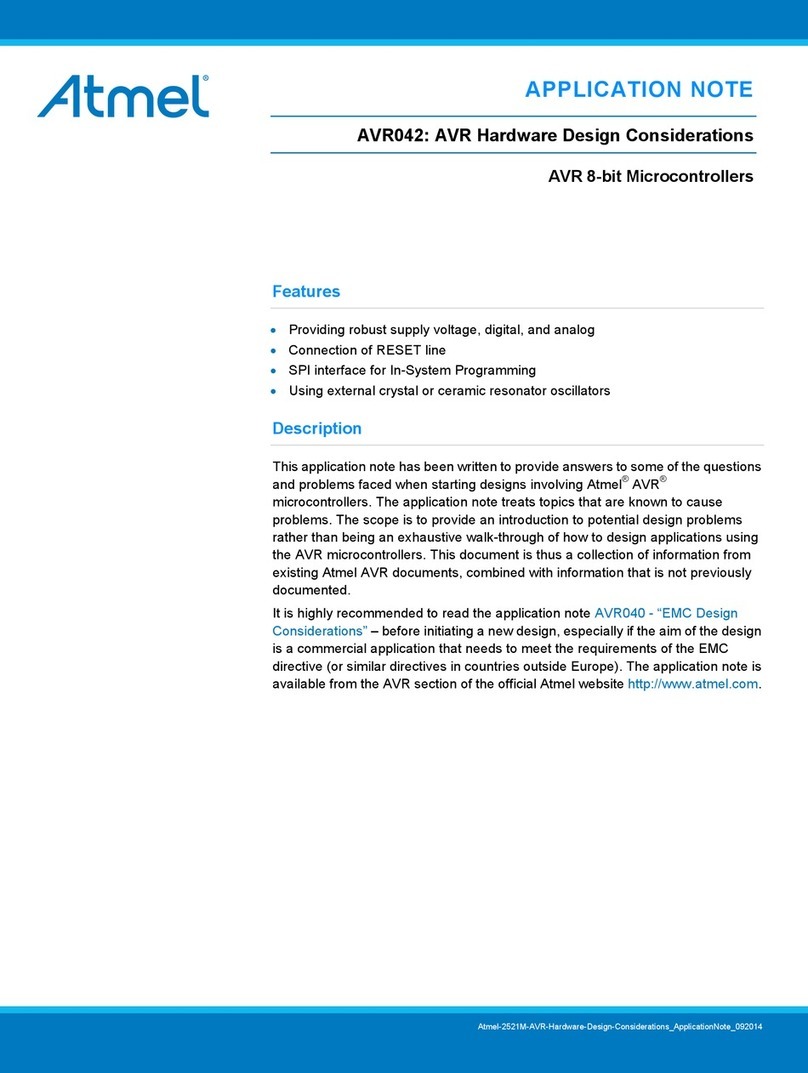
Atmel
Atmel AVR042 Application note
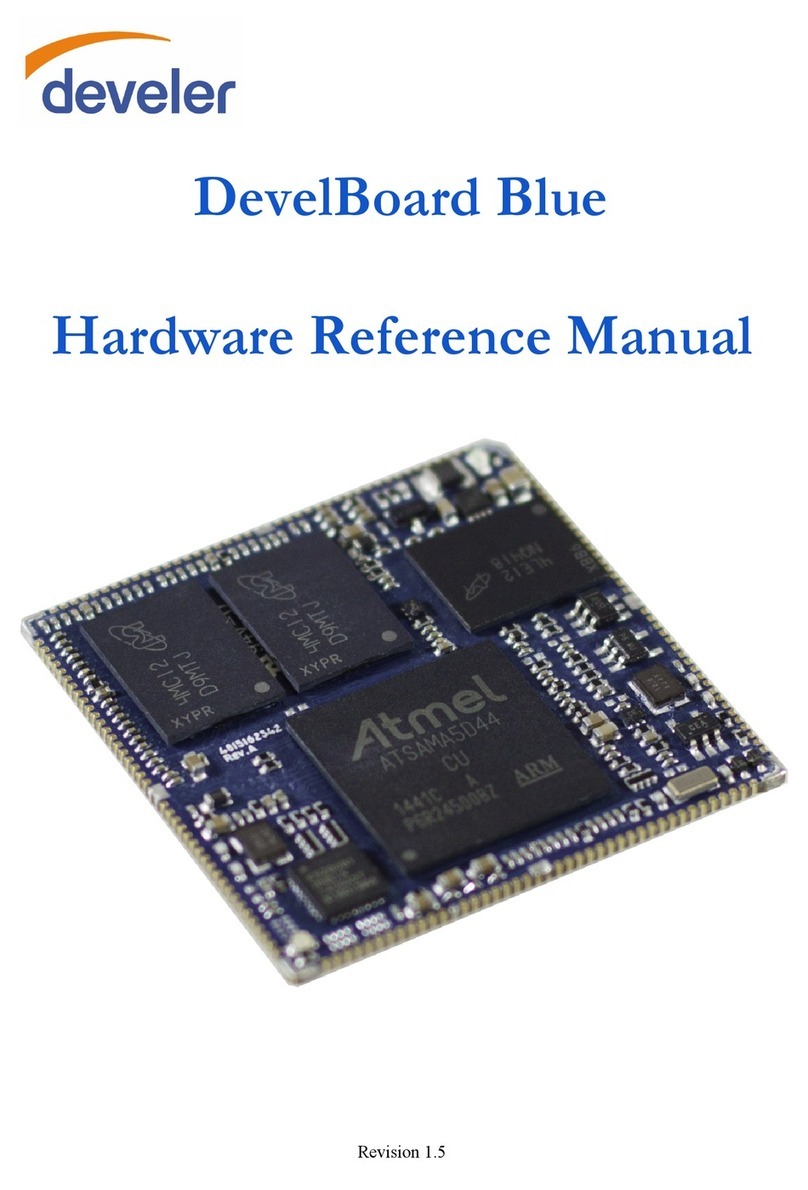
Atmel
Atmel develer DevelBoard Blue Hardware reference manual
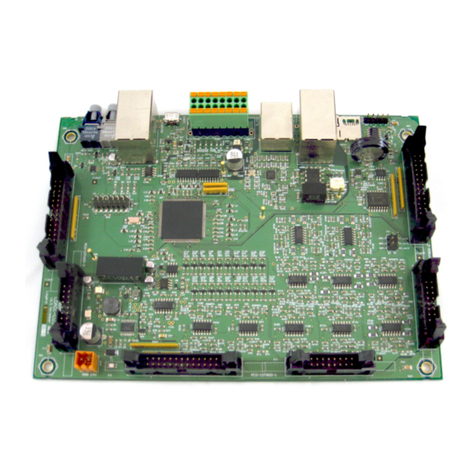
Texas Instruments
Texas Instruments Concerto F28M35 Series Technical reference manual
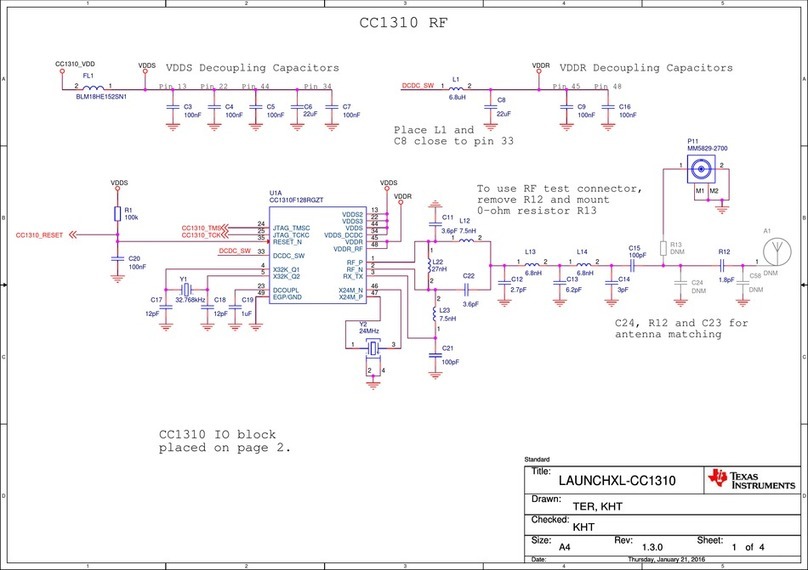
Texas Instruments
Texas Instruments LAUNCHXL-CC1310 Wiring diagrams

Eurotech
Eurotech ANTARES user manual
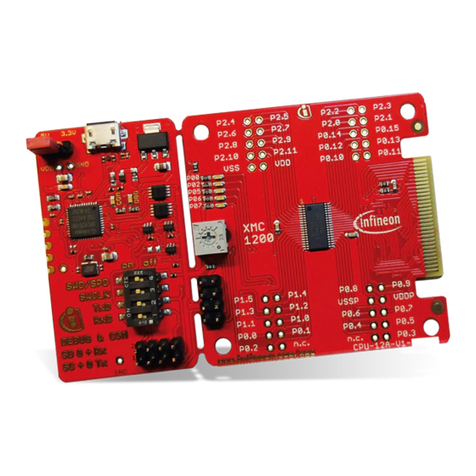
Infineon
Infineon XMC1000 Getting started
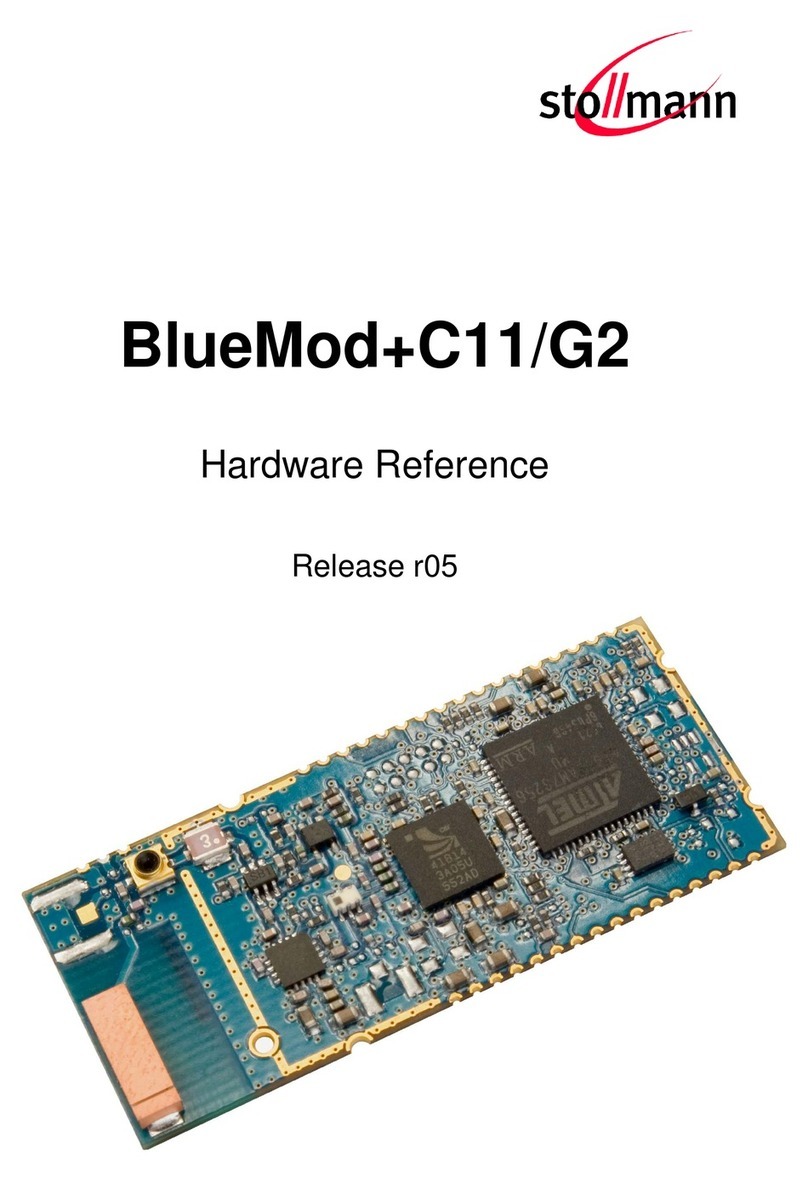
Stollmann
Stollmann BlueMod+C11/G2 Series Hardware reference
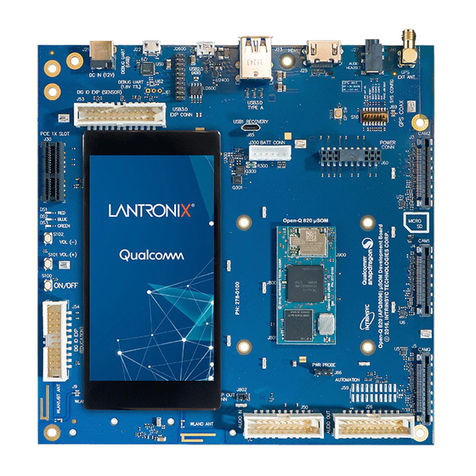
Intrinsyc
Intrinsyc LANTRONIX Open-Q 820 user guide
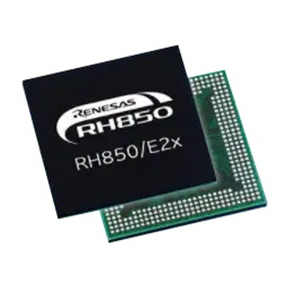
Renesas
Renesas RH850 Series Application note
Dialog Semiconductor
Dialog Semiconductor DA1468 series user manual
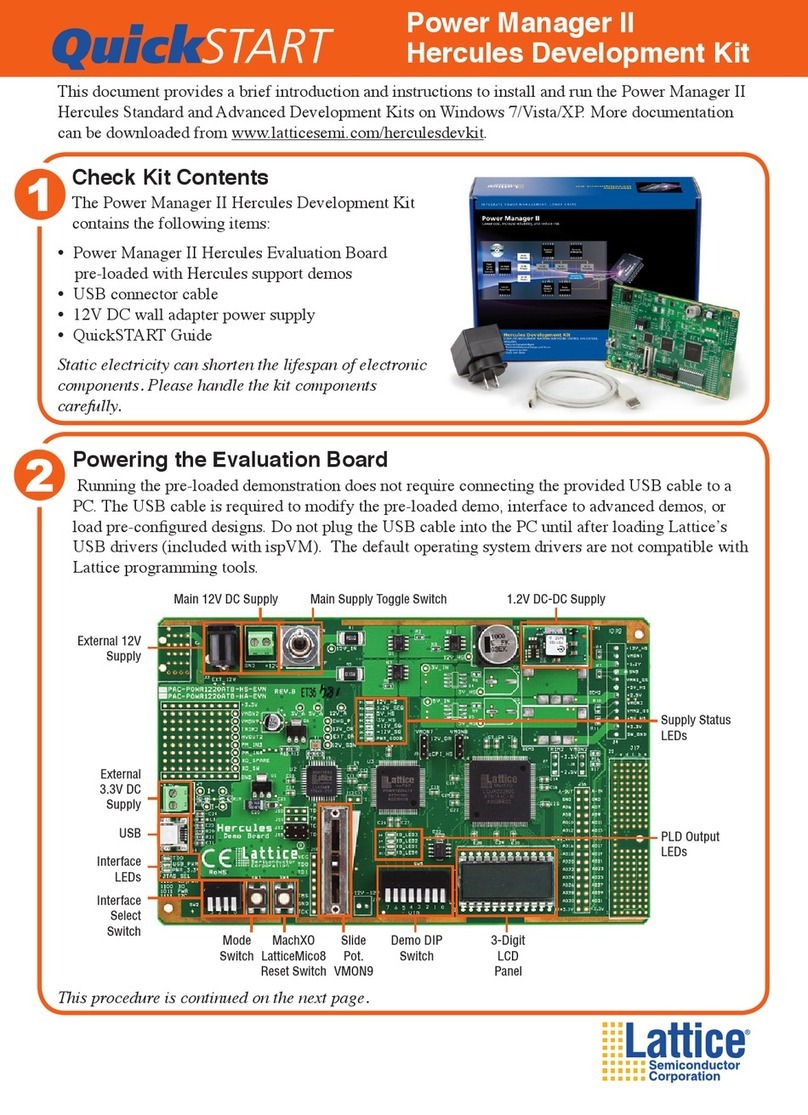
Lattice
Lattice Power Manager II Hercules quick start
